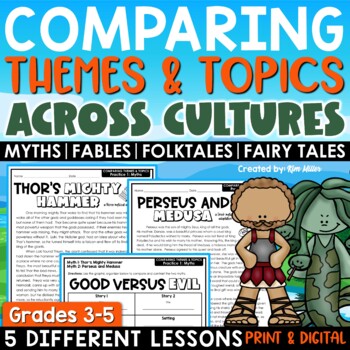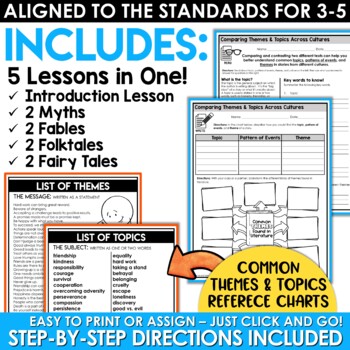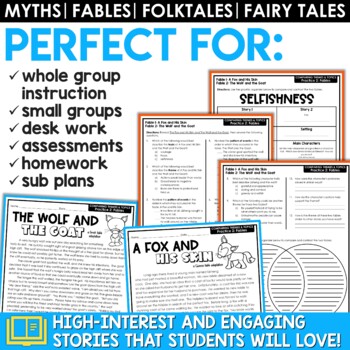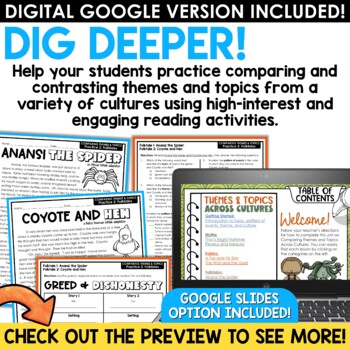Compare and Contrast Themes and Topics Across Cultures Teaching Theme
- PDF
- Internet Activities
- Easel Activity
What educators are saying
Description
Teaching students how to compare and contrast themes and topics across cultures can be difficult, but it doesn't have to be! This resource helps students compare traditional literature stories based on similar themes, topics, and patterns of events in myths, fables, folktales, and fairytales. A total of 5 lessons are included that guide students through finding similarities and differences within a variety of stories and genres.
The activities included in this packet are perfect for students in grades 3-5. Through careful reading, students will:
- compare and contrast themes, settings, plots, and similar characters found within stories
- compare and contrast the treatment of similar themes, topics, and patterns of events in stories, myths, and traditional literature from different cultures
- compare and contrast the same genre with similar themes and topics
This resource includes:
- Introduction Lesson: Understanding the difference between topic, patterns of events, theme, and culture
- Common Themes in Literature (Reference Chart)
- Common Topics in Literature (Reference Chart)
- Practice #1: Myths - students compare and contrast two myths
Thor’s Mighty Hammer (a Norse mythical adaptation)
Perseus & Medusa (a Greek mythical adaptation)
- Practice #2: Fables - students compare and contrast two fables
A Fox & His Skin (a Chinese fable adaptation)
The Wolf & the Goat (a Greek fable adaptation)
- Practice #3: Folktales - students compare and contrast two folktales
Anansi the Spider (an African folktale adaptation)
Coyote & the Hen (a Native American folktale adaptation)
- Practice #4: Fairy Tales - students compare and contrast two fairy tales
Sootface (an Ojibwa fairy tale adaptation)
Yeh-Shen (a Chinese fairy tale adaptation)
- Digital Google Option
- TpT Easel Activity Digital Option
- Answer Keys
Each engaging lesson follows the same format:
- students read 2 traditional literature stories from different cultures and genres (myths, fables, folktales, and fairy tales.
- students answer 12 reading comprehension questions related to the topic, patterns of events, theme, setting, character traits, and vocabulary
- students use a Venn diagram to compare and contrast similarities and differences found in the two stories
- students use a chart to compare the two stories using setting, character traits, and conclusion of events while citing text evidence
⭐ Print and go or assign digitally! Each printable lesson is also included in a digital format using Google Slides.
These activities are perfect for:
- whole group instruction
- small groups
- independent desk work
- assessments
- homework
- sub plans, and so much more!
The best part?
Your students will quickly learn how to compare and contrast themes, topics, characters, settings, and events in each story as they draw on specific details in the text. They will get right to work identifying similarities and differences found in each set of stories from a variety of cultures and genres.
Teachers like you said…
⭐⭐⭐⭐⭐This was one of my favorite resources I have used this year. I uploaded this as an independent work on my google classroom to check for understanding. I allowed students to do part of it as partners and then the rest on their own. It was both challenging and good for writing purposes. It truly does offer a lot of diversity which was hard to do using an online platform. Thank You! - Cara M.
⭐⭐⭐⭐⭐Finding texts to teach this standard was the bane of my existence this year, but this was exactly what I needed! Worked perfectly for guided reading. - Miss Bruce Elementary
⭐⭐⭐⭐⭐This is a fantastic resource! The folktales are interesting and engaging. I loved that this included graphic organizers to help students break down the story elements (a great review) before comparing. We used those elements to guide our lessons on compare/contrast. Overall, high-quality texts with awesome graphic organizers. - Emily F.
⭐⭐⭐⭐⭐I loved that this product had examples of several genres of fiction texts for students to use when analyzing and comparing themes. This product provides clear examples of students identifying themes of texts, as well as comparing character reactions to events in the texts. I loved the digital component of this product, which made it easy to adapt for distance learning. - Tracy P.
In this one convenient resource, you can…
- have ready-to-go activities that will help your students master comparing and contrasting themes and topics across cultures.
- use these pre-made activities as sub plans when you need to take a day (or week) off!
- print and go or assign digitally - includes everything you need to teach this comparing and contrasting skills anytime during the year!
Supports Common Core Standards (CCSS)
Created for: CCSS.ELA-LITERACY.RL.4.9
Compare and contrast the treatment of similar themes and topics (e.g., opposition of good and evil) and patterns of events (e.g., the quest) in stories, myths, and traditional literature from different cultures.
Also meets the following standards:
RL.3.2, RL.3.3, RL.3.9
RL.4.2, RL.4.3, RL.4.9
RL.5.2, RL.5.3, RL.5.9
You may also like…
Teaching Theme with Aesop's Fables | Finding Theme Worksheets Graphic Organizers
Teaching Theme Posters by Topic | Themes in Literature
Teaching Theme Using Quotes Activities, Worksheets, and Graphic Organizers
Teaching Theme Reading Passages Activities Using Close Reading Strategies
Click ★HERE★ to follow my store and be notified when new products are uploaded.
All new resources are 50% off for the first 24 hours!
⭐ Please note: If you are having difficulty with this file, please visit the FAQs section, submit a help ticket, or ask me a question on the Q&A tab before leaving feedback.
Copyright © Kim Miller (A Love of Teaching)
Permission to copy for single classroom use only.
Please purchase additional licenses if you intend to share this product.






